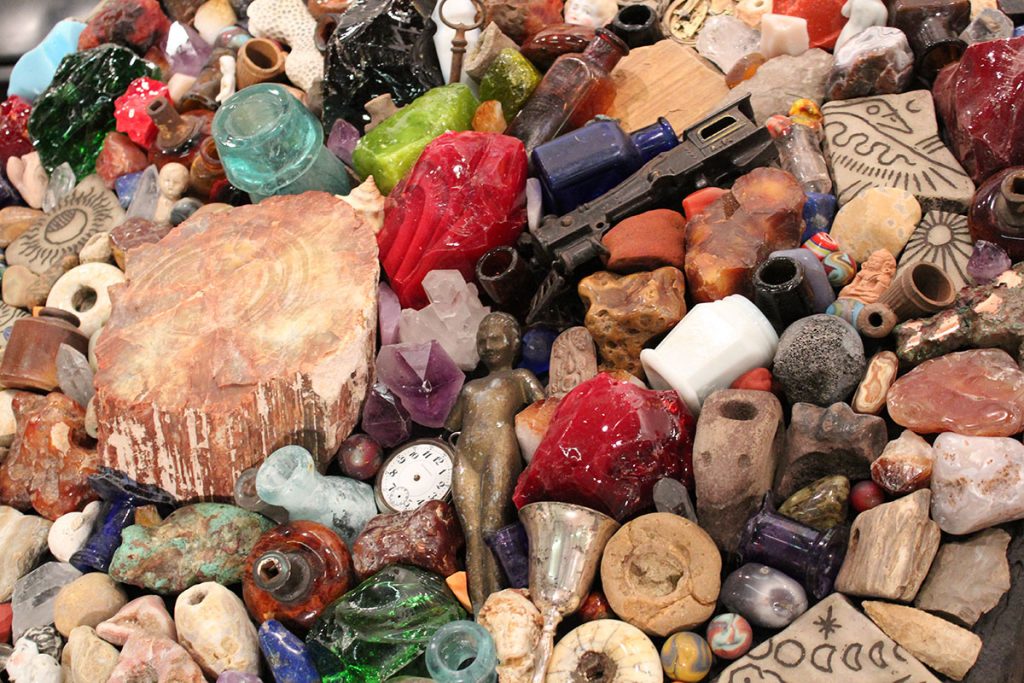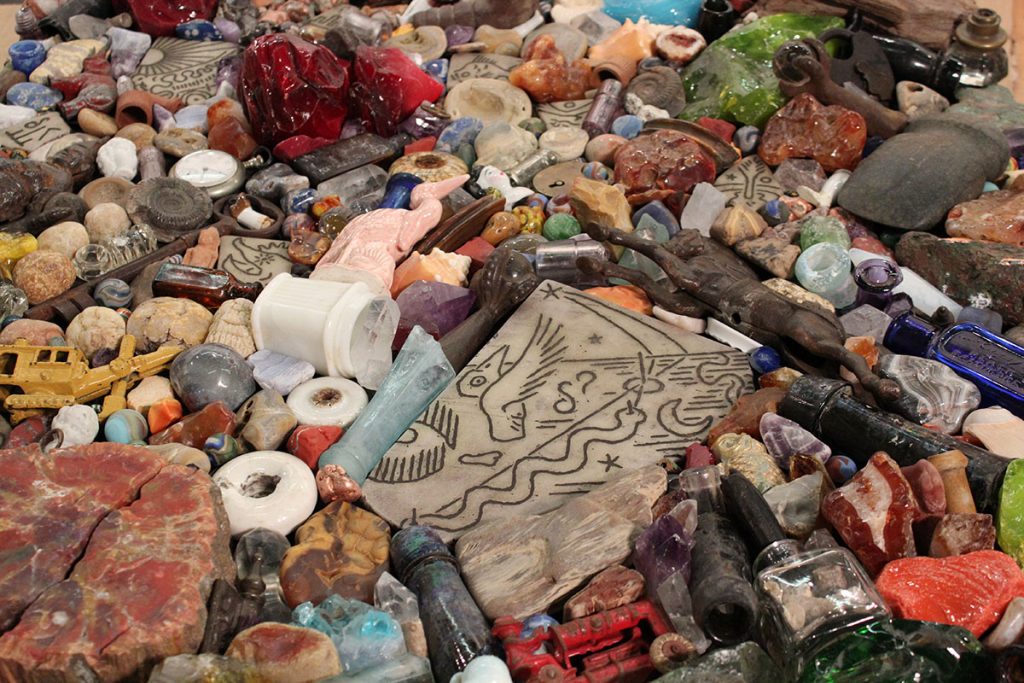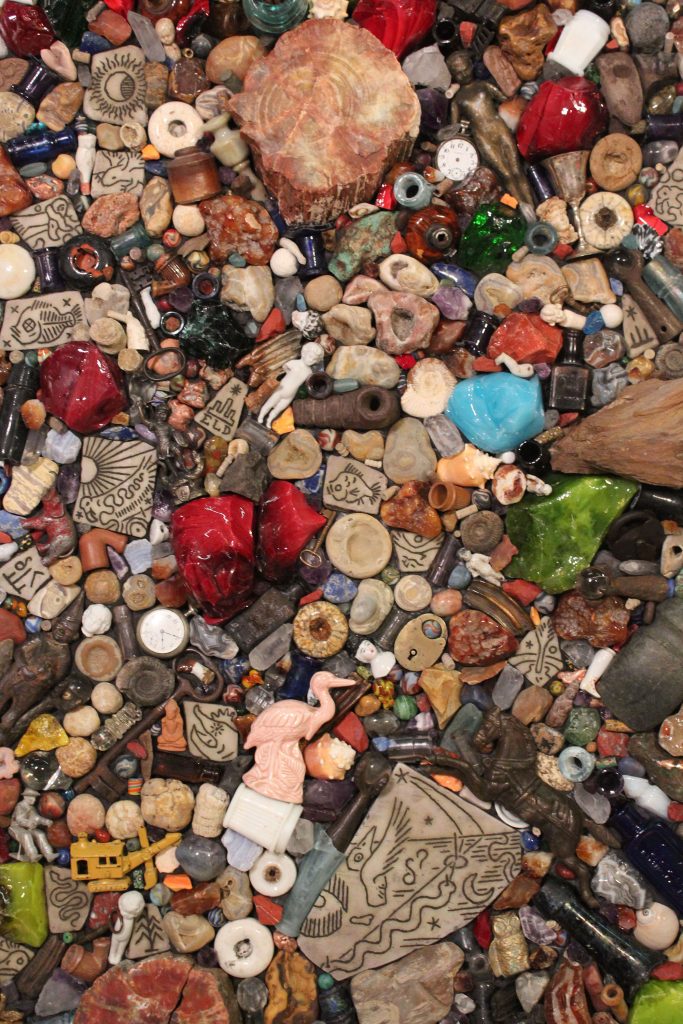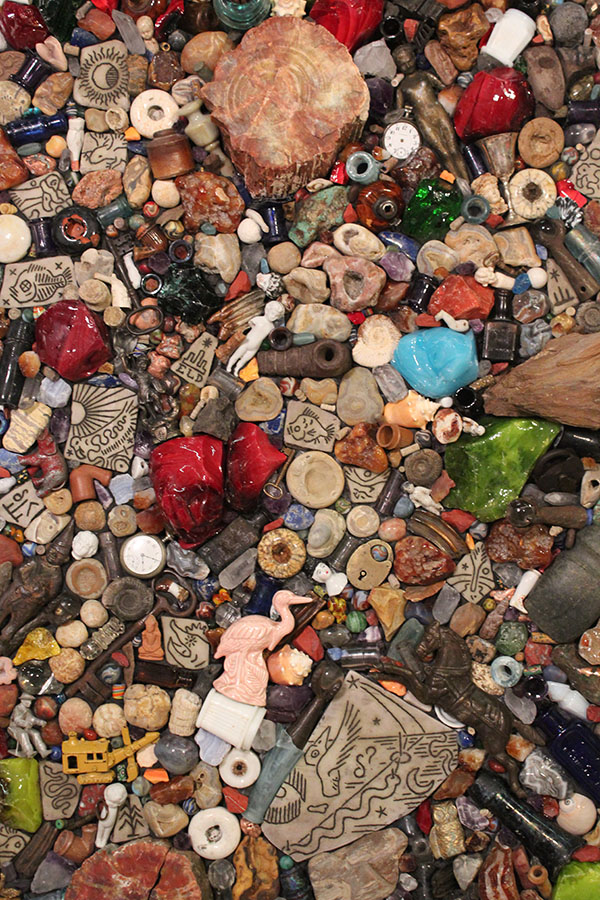I sometimes make found-object sculptures and surfaces with many different types of objects but without conventional tile or with conventional tile used only for a particular element.
All of these found objects are made from durable materials such as glass, porcelain, and hard varieties of stones
If the mosaic is indoors, I will also make limited use of metal objects and softer ceramic materials that wouldn’t be durable outdoors.
In these mosaics, I nest these non-flat objects next to each other so that they are touching and the finished surface is a rough collage.
Naturally, these mosaics aren’t grouted, which would be problematic for several reasons including staining porous objects and filling the details of embossed objects.
The bottom of my page about thinset mortar explains how I handle the mortar to mount these objects of odd shapes and sizes.
What that page doesn’t explain are the steps I used to design the more elaborately nested designs and ensure the objects were equally well-nested over the entire surface.

Pressing objects into wet mortar without this close degree of nesting can be improvised and kept fairly consistent by using a gap, but that wasn’t the look I wanted.
I wanted the irregular objects to nest tightly like a stack and have some objects mounted on end instead of lying flat.
That requires solving a 3-D puzzle, and that was not something I wanted to try to figure out with wet sticky mortar hardening on my hands.

Nesting in Two Dimension
Even when you place all objects as flatly as possible and think of the objects primarily in terms of their 2-D footprint, you still have to think ahead to get the nesting right.
Objects with concave sides or armatures (stars, figurines, crosses, etc.) are a challenge.
Improvising the nesting instead laying out all the objects in advance often leaves a bare spot between two of the armatures that is larger than any bare spot anywhere else in the composition.
Or the object you selected to fill that spot has some sort of issue that you don’t notice until after the mortar has hardened.
By issue, I mean thematic or color or pattern or some other aesthetic concern that was invisible while your mind was preoccupied solving nesting issues but is now glaringly obvious to fresh eyes the next day.

3-D Nesting
I knew I couldn’t consistently improvise the degree of 3-D nesting I wanted even if I ignored other aesthetic concerns.
That meant I had to carefully arrange all the objects in advance, and somehow mount them one at a time into mortar that was dispensed exactly where it was needed using palette knives or a modified grouting bag.
Either way, it required removing each object and replacing it without disrupting the surrounding objects.
That was mainly a matter of dexterity and patience.
The greater challenge was coming up with the composition.
Things look random, but it takes some trial and error to satisfy all the constraints:
- color contrast
- shape and height transitions
- close nesting without any blank space
- show the best aspect/face of each object
- juxtaposition of types/themes of items.
That last constraint was mainly a matter of not allowing any one category of item dominate an area.
There are many arrangements that nominally satisfy all five constraints but aren’t as interesting as what is possible.
I tried a gazillion different ways of laying out certain areas until I found the rhythm again, and things would flow together like water for a while.
But then I’d hit a problematic object and be stuck over what to put next to it to balance it in all ways.
For this reason, the first draft layout took me weeks and weeks.
Mounting everything in mortar took less than two weeks, with progress being slow at first and then more and more efficient with practice.

Procedure
I wrote up this procedure based on what I did making this mosaic sculpture. I made sure I saw the composition with fresh eyes at least once after any changes or technical problems:
- Collect objects over extended period (lifetime, years).
- Rinse, clean, and sort objects.
- Arrange objects on the backer or template/tray (days or weeks).
- Declare first draft finished.
- Work on separate project(s) (at least a day or two).
- Look at composition and revise arranged objects if needed.
- Repeat steps 5 and 6 as needed
- Choose a small area of the mosaic that is central yet not a focal point.
- Carefully mount these few objects one at a time using thinset mortar.
- Notice problems such as displacement of adjacent objects.
- Evaluate rest of the mosaic in terms of these problems.
- Revise arrangement if needed.
- Sleep on it and re-evaluate the composition.
- Mount the remaining objects working from the center outward.
- Replace any displaced (bumped) objects at the end of each studio session.

Of course, I could have been a lot more casual with a smaller composition, but I was as cautious as possible with a project of this size.
I made a conscious effort to pace myself and not get in a rush merely because I had so much area to cover.
Notice how early the completion of the “first draft” occurs early in the steps even though that first draft took weeks.
Notice how every change is looked at the next morning with fresh eyes.
I didn’t have any choice. Cementing this many artifacts and antiques into one sculpture was a commitment beyond the usual time and money. There was the beauty and intrinsic worth of the items, and I didn’t want to screw it up.


Leave a Reply